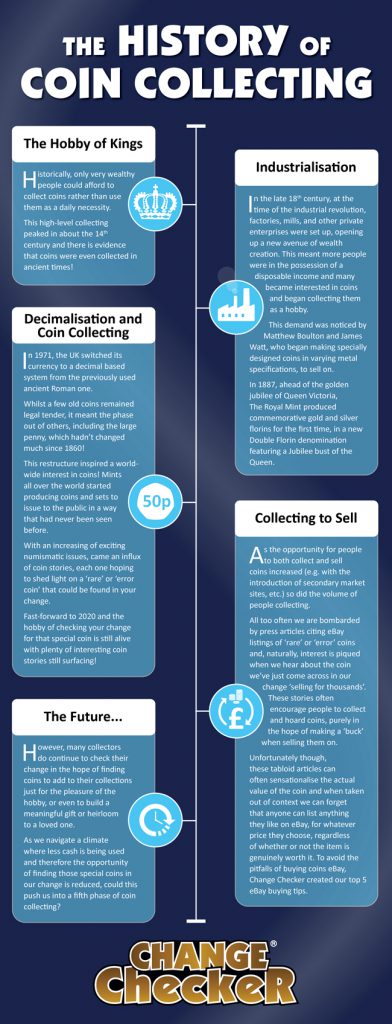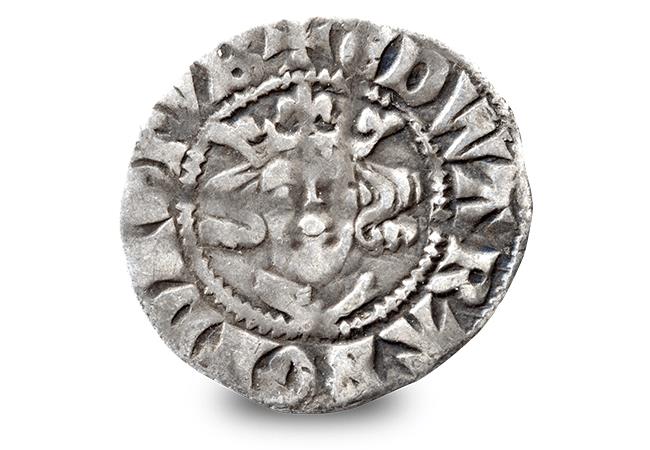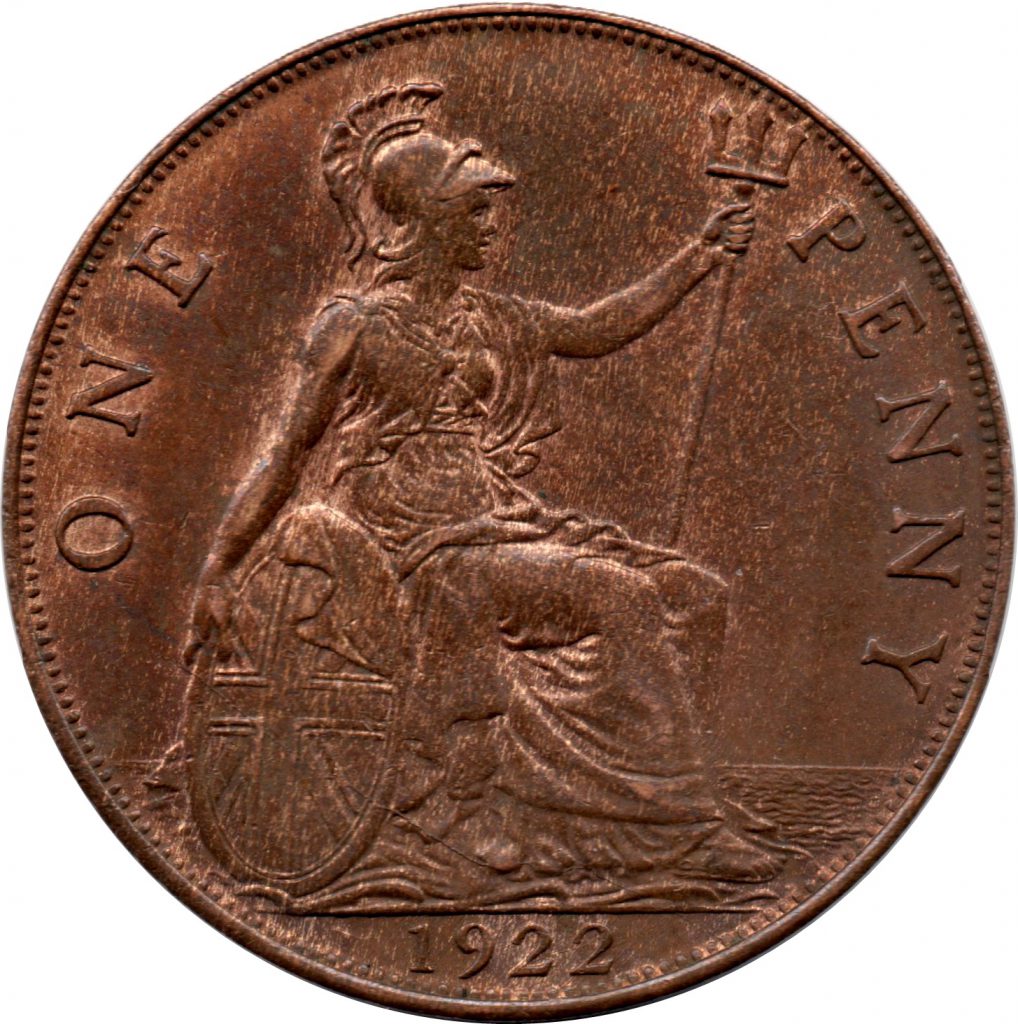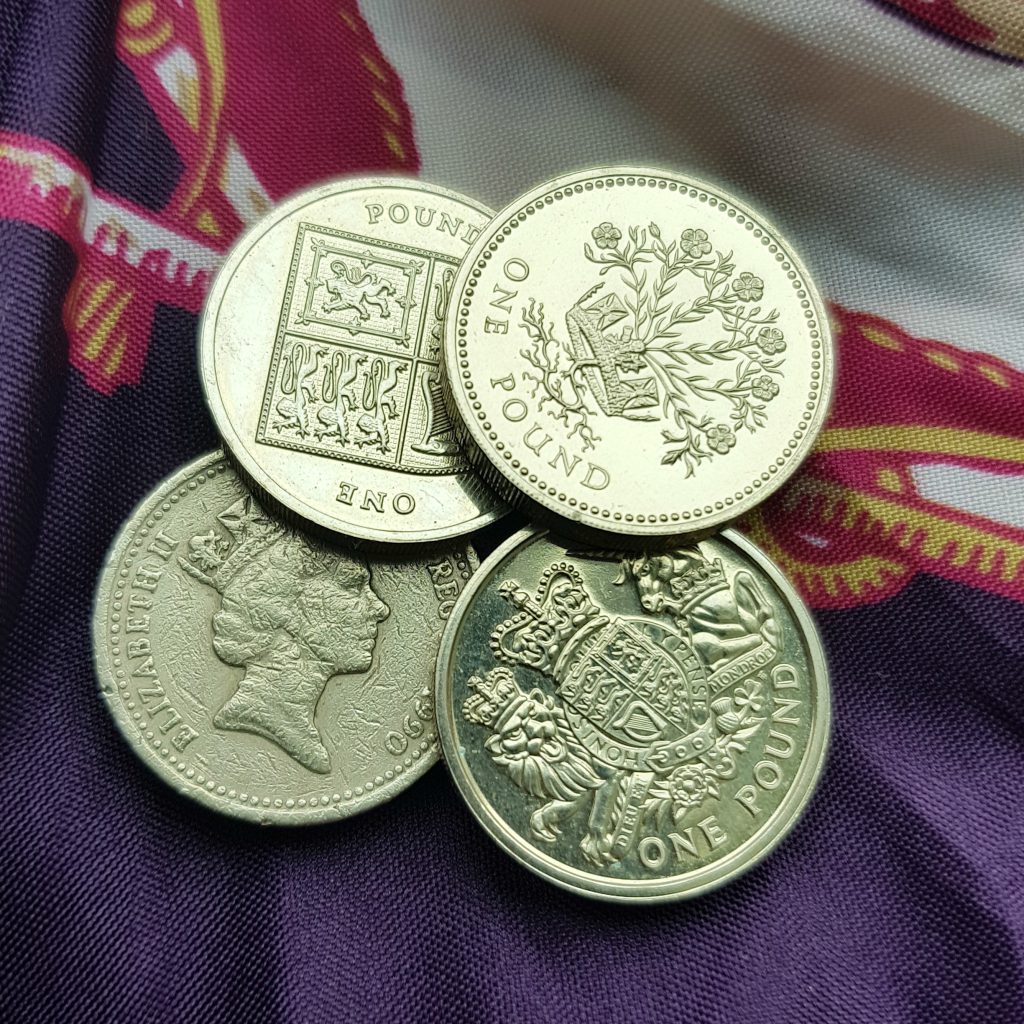Uncategorised
The History of Coin Collecting
Coin collecting is a hobby that spans across generations, but did you know it also spans across centuries?
In this blog, we talk you through the different phases of coin collecting!

The Hobby of Kings
Historically, only very wealthy people or royals could afford to collect coins rather than use them as a daily necessity.

This high-level collecting peaked in about the 14th century and there is evidence that coins were even collected in ancient times!
Industrialisation
In the late 18th century, at the time of the industrial revolution, factories, mills, and other private enterprises were set up, opening up a new avenue of wealth creation. This meant more people were in possession of a disposable income and many became interested in coins and began collecting them as a hobby.
This demand was noticed by Matthew Boulton and James Watt, who began making specially designed coins in various metal specifications, to sell on.
In 1887, ahead of the golden jubilee of Queen Victoria, The Royal Mint produced commemorative gold and silver florins for the first time, a new Double Florin denomination featuring a Jubilee bust of the Queen.

This was to start a tradition of producing ‘special’ coins to mark particular historic or royal anniversaries that carried through to the 20th century.
Decimalisation and Coin Collecting
In 1971, the UK switched its currency to a decimal based system from the previously used system dating back to ancient Roman times.
Whilst a few old coins remained legal tender, it saw the phase out of others, including the large penny, which hadn’t changed much since 1860!

This restructure inspired a world-wide interest in coins! Mints all over the world started producing coins and sets to issue to the public in a way that had never been seen before.
With an increasing of exciting numismatic issues, came an influx of coin stories, each one hoping to shed light on a ‘rare’ or ‘error coin’ that could be found in your change.
Fast-forward to 2020 and the hobby of checking your change for that special coin is still alive with plenty of interesting coin stories still surfacing!
Collecting to Sell
As the opportunity for people to both collect and sell coins increased (e.g. with the introduction of secondary market sites, etc.) so did the volume of people collecting.
All too often we are bombarded by press articles citing eBay listings of ‘rare’ or ‘error’ coins and, naturally, interest is piqued when we hear about the coin we’ve just come across in our change ‘selling for thousands’. These stories often encourage people to collect and hoard coins, purely in the hope of making a ‘buck’ when selling them on.
Unfortunately though, these tabloid articles can often sensationalise the actual value of the coin and when taken out of context we can forget that anyone can list anything they like on eBay, for whatever price they choose, regardless of whether or not the item is genuinely worth it. To avoid the pitfalls of buying coins eBay, Change Checker created our top 5 eBay buying tips.

However, many collectors do continue to check their change in the hope of finding coins to add to their collections just for the pleasure of the hobby, or even to build a meaningful gift or heirloom to a loved one.
As we navigate a climate where less cash is being used and therefore the opportunity of finding those special coins in our change is reduced, could this push us into a fifth phase of coin collecting?
Secure the History of Britain in Coins Collecting Album!
Secure one to your collection today by clicking here >>
BRAND NEW Winnie the Pooh 50p Series Released – could these be the most sought-after 50ps yet?
“It isn’t much good having anything exciting, if you can’t share it with somebody.” said Winnie the Pooh
In 2020, The Royal Mint announced a brand new 9-coin 50p collection celebrating the beloved Winnie the Pooh books!
The final coin in the collection has now been released, celebrating Britain’s best-loved bear and his friends from the Hundred Acre Wood.
2022 UK Winnie the Pooh and Friends 50p

As the perfect way to round off the collection, this final coin features a heart-warming design of Winnie and his friends – including Piglet, Eeyore and Tigger – together in the Hundred Acre Wood.
The nostalgic coin brings to life the classic illustrations by E.H. Shepard from the much-loved children’s novels – celebrating over 95 years of fun-filled adventures.
If you look closely, a buzzing bumblebee can even be seen flying across the coin as a unifying feature across each 50p in the series.
Today, you can welcome this brand new 50p into your collection for JUST £4.99 (+p&p), by clicking here >>
Your coin has been struck to a Brilliant Uncirculated quality, protectively encapsulated in Official Change Checker packaging to ensure that its superior quality is preserved forever.
2022 UK Kanga and Roo 50p
The sweet, gentle, and kind-hearted Kanga has joined the Winnie the Pooh 50p collection, accompanied by her adventurous son, Roo.
The nostalgic reverse design featuring these delightful characters brings to life the classic illustrations by E.H. Shepard from the much-loved children’s novels.
Kanga was based off Christopher Robin’s real-life stuffed animal and in A. A. Milne’s stories, E. H. Shepard illustrates her with brown fur all over. Although kangaroos traditionally have a ‘pouch’, A. A. Milne describes Kanga’s as a ‘pocket’, in which her son Roo is often safely tucked into.
And now, you can tuck this brand new 50p straight into your collection, for JUST £4.99 (+p&p), by clicking here >>
Your coin has been struck to a Brilliant Uncirculated quality, protectively encapsulated in Official Change Checker packaging to ensure that its superior quality is preserved forever.
2022 UK Eeyore 50p

The clever, brilliant, and witty Eeyore also joined his friends in the Winnie the Pooh 50p collection, with his tail firmly attached!
Featuring a design taken from E. H. Shepard’s original illustrations, this 50p shows the loveable, old, grey stuffed donkey, just as we remember him from A. A. Milne’s books.
Although famous for his melancholic nature, Eeyore’s loyalty always wins the hearts of his friends from Hundred Acre Wood, especially when he loses his tail.
And he’s been winning over the hearts of collectors up and down the country with this brand new 50p!
Certain to rival the popularity of the previous Winnie the Pooh 50p coins, this brand new coin has been issued in Brilliant Uncirculated quality.
Secure this brand new coin for your collection for JUST £4.99 (+p&p) by clicking here >>
2021 Tigger, Owl, and Winnie the Pooh and Friends 50p coins
Last year’s additions to the Winnie the Pooh 50p Collection saw Owl and Tigger join their friends from Hundred Acre Wood on the 50p.

On the design of the Tigger 50p, we see the bouncy character hopping around just as he does in E. H. Shepard’s original illustrations – on all four legs!
Sitting tall and proud on his 50p, Owl can be seen with quill and paper at the ready. Always on hand to share his advice (even when it may not be wanted!), Owl is the wisest inhabitant of Hundred Acre Wood.
We also saw all the main characters from A. A. Milne‘s classic tale feature on one 50p together. The Winnie the Pooh and Friends 50p proved a huge hit with coin collectors and fans of the books too!
2020 Winnie the Pooh, Christopher Robin, and Piglet 50p Coins
The first three coins in the series feature designs of Winnie the Pooh, Christopher Robin, and Piglet and were some of the most sought-after coins of the year!

First in the series we saw Winnie the Pooh himself, just as we remember him, with a reverse design by The Walt Disney Company which features an original illustration from the Winnie the Pooh storybooks by E.H. Shepard.
Following closely behind we see Pooh’s most-trusted companion and friend, Christopher Robin, who featured on the second 50p in the 2020 series! Concluding the 2020 series, the character with the biggest heart in all of Hundred Acre Wood, Piglet, made his UK 50p debut.
If you’re yet to secure the coins in the Winnie the Pooh 50p collection, you can browse the range here >>
The Story Behind the Classic
Winnie the Pooh was a collection of short stories first published in 1926 by A.A. Milne, for his son, Christopher Robin.

Most of Christopher Robin’s real life toys were the inspiration for A.A. Milne’s characters, but most significantly his favourite teddy bear which Winnie the Pooh himself is based on!
Alongside Winnie the Pooh, the fictional Hundred-Acre-Wood is inhabited by:
- The timid but sometimes brave, Piglet
- The glum but loveable donkey, Eeyore
- The bouncy, one-of-a-king, Tigger
- The loving and gentle, Kanga and her baby Roo
- The terribly organised Rabbit,
- The wise, old, Owl, and
- The scary, honey-stealing Heffalumps!
The timeless and universal appeal of this silly old bear is unparalleled. He’s featured in 3 books, various film adaptations, and much much more.
And now we see the best-loved characters from the books feature together on the nation’s best-loved coin, the 50p.
Could these 50p coins become the most sought-after issues?
We’ve seen some incredible character 50ps in the past, which have been a world-wide hit with collectors.
In 2019, to mark the 20th Anniversary of Julia Donaldson’s much-loved children’s book The Gruffalo®, a new 50p was issued.
This coin was so popular that the silver-proof version completely SOLD OUT at the Royal Mint within 12 hours of its release, making it the fastest selling and most popular 50p ever. That’s a 50p sold every 2 seconds!
We’ve also seen the huge popularity of the Beatrix Potter 50ps, issued to celebrate the life and work of Beatrix Potter and the 150th Anniversary of her birth.
These coins were so popular amongst collectors, they reached heights that hadn’t been seen since the 2011 Olympic 50p series. Collectors of all ages were racing to add these coins to their collections and to gift them to friends and family.
And now that a new series has been issued featuring an all-time favourite childhood character, could we see these coins becoming even more popular than the likes of the 50ps mentioned above?
This brand new and final coin in the series is sure to be a hit with coin collectors and Winnie the Pooh fans alike!
Do you have the full collection of Winnie the Pooh 50ps? Comment below!
Fill the gaps in your Winnie the Pooh Collection!
With all 9 coins now available to own in Brilliant Uncirculated quality and prices starting from just £4.99 (+p&p), don’t miss this chance to complete this wonderful collection of 50ps.
Click here to browse the full range >>
Your coins will come protectively encapsulated in Official Change Checker packaging to ensure that their superior quality is preserved for generations to come.
©Disney. Based on the “Winnie the Pooh” works by A. A. Milne and E. H. Shepard.
Is time up for our 2ps? Production of 2p and £2 coins could be halted for the next 10 years!
In March 2015, the UK treasury confirmed that 1p and 2p coins will continue to be used “for years to come”. However, it has recently been suggested that due to a cash usage slump, The Royal Mint is set to go ten years without producing anymore 2p coins!
But it’s not just our coppers at stake.. The same applies for £2 coins, as it has been revealed that in March 2020, The Royal Mint was sitting on 26 times as many £2 coins as it needed to.
According to the National Audit Office’s report into Britain’s cash usage, the number of coins produced each year by The Royal Mint fell by nearly two-thirds between 2011 and this year.
Less than a quarter of all payments were made by cash last year, according to figures released in June by the banking trade body UK Finance.
It’s fair to assume that even less cash has been used since the start of 2020 due to the coronavirus leading to fears of cash usage and a move to more contactless payments.
However, The Mint told Britain’s spending watchdog that there had been ‘sharp increases in demand’ for change ‘as many businesses and consumers hoarded coins in the early months of the pandemic’.
As a result, the Treasury ordered The Royal Mint to strike 60 million additional 1p coins over the summer to meet this new demand. So make sure you keep your eyes peeled for these new 1p coins, especially if you’re collecting dateruns!
The Royal Mint are required to forecast the demand for small change to ensure it keeps enough coins in stock without striking too few or too many, but with significant fluctuations in consumer behaviour in recent years, this has no doubt been a challenge.

In 2017, after the introduction of the new 12-sided £1, The Royal Mint saw a swell in its coin stocks as people rushed to return their round pounds, ending up returning loose change of other denominations at the same time.

According to the NAO, at the end of March, The Royal Mint aimed to hold 700,000 £2 coins, but actually held 18.7million. And rather than holding its target of 15.9million 2p coins, it held 127.1million.
As a result, in March of this year, The NAO said The Royal Mint had estimated ‘it did not envisage producing any new 2p or £2 coins for at least 10 years’.
We haven’t seen a £2 enter circulation since 2016, so, could this mean that those 2016 dated £2s and 2017 dated 2p coins are the last of their kind? We certainly hope not.
But what about our coppers? Do you think we still need 1p and 2p coins in circulation? Have your say by voting in our poll on Facebook.
And what could the future for Britain’s definitive coinage be if the 1p and 2p coins were removed? Currently the definitive coins from 1p to 50p come together to create The Royal Shield, but with two key pieces missing, could this lead to a complete re-design?
We’d love to hear what you think about the use of cash vs card and the demand for our smaller denominations, so leave us a comment below to share your thoughts.
If you’re interested in coin collecting, our Change Checker web app is completely free to use and allows users to:
– Find and identify the coins in their pocket
– Collect and track the coins they have
– Swap their spare coins with other Change Checkers

Sign up today at: www.changechecker.org/app






